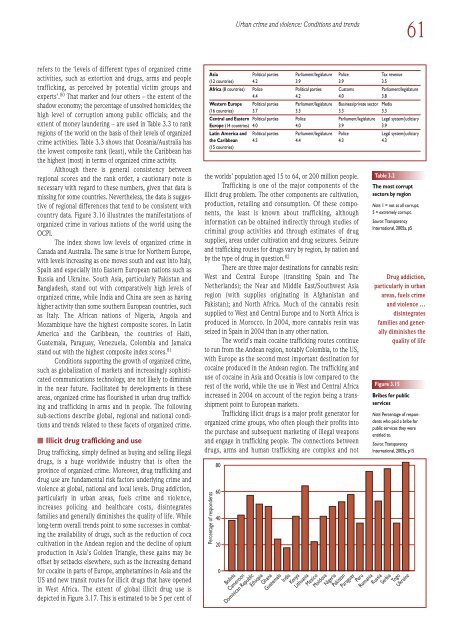Download the file - United Nations Rule of Law
Download the file - United Nations Rule of Law
Download the file - United Nations Rule of Law
- No tags were found...
Create successful ePaper yourself
Turn your PDF publications into a flip-book with our unique Google optimized e-Paper software.
Urban crime and violence: Conditions and trends61refers to <strong>the</strong> ‘levels <strong>of</strong> different types <strong>of</strong> organized crimeactivities, such as extortion and drugs, arms and peopletrafficking, as perceived by potential victim groups andexperts’. 80 That marker and four o<strong>the</strong>rs – <strong>the</strong> extent <strong>of</strong> <strong>the</strong>shadow economy; <strong>the</strong> percentage <strong>of</strong> unsolved homicides; <strong>the</strong>high level <strong>of</strong> corruption among public <strong>of</strong>ficials; and <strong>the</strong>extent <strong>of</strong> money laundering – are used in Table 3.3 to rankregions <strong>of</strong> <strong>the</strong> world on <strong>the</strong> basis <strong>of</strong> <strong>the</strong>ir levels <strong>of</strong> organizedcrime activities. Table 3.3 shows that Oceania/Australia has<strong>the</strong> lowest composite rank (least), while <strong>the</strong> Caribbean has<strong>the</strong> highest (most) in terms <strong>of</strong> organized crime activity.Although <strong>the</strong>re is general consistency betweenregional scores and <strong>the</strong> rank order, a cautionary note isnecessary with regard to <strong>the</strong>se numbers, given that data ismissing for some countries. Never<strong>the</strong>less, <strong>the</strong> data is suggestive<strong>of</strong> regional differences that tend to be consistent withcountry data. Figure 3.16 illustrates <strong>the</strong> manifestations <strong>of</strong>organized crime in various nations <strong>of</strong> <strong>the</strong> world using <strong>the</strong>OCPI.The index shows low levels <strong>of</strong> organized crime inCanada and Australia. The same is true for Nor<strong>the</strong>rn Europe,with levels increasing as one moves south and east into Italy,Spain and especially into Eastern European nations such asRussia and Ukraine. South Asia, particularly Pakistan andBangladesh, stand out with comparatively high levels <strong>of</strong>organized crime, while India and China are seen as havinghigher activity than some sou<strong>the</strong>rn European countries, suchas Italy. The African nations <strong>of</strong> Nigeria, Angola andMozambique have <strong>the</strong> highest composite scores. In LatinAmerica and <strong>the</strong> Caribbean, <strong>the</strong> countries <strong>of</strong> Haiti,Guatemala, Paraguay, Venezuela, Colombia and Jamaicastand out with <strong>the</strong> highest composite index scores. 81Conditions supporting <strong>the</strong> growth <strong>of</strong> organized crime,such as globalization <strong>of</strong> markets and increasingly sophisticatedcommunications technology, are not likely to diminishin <strong>the</strong> near future. Facilitated by developments in <strong>the</strong>seareas, organized crime has flourished in urban drug traffickingand trafficking in arms and in people. The followingsub-sections describe global, regional and national conditionsand trends related to <strong>the</strong>se facets <strong>of</strong> organized crime.■ Illicit drug trafficking and useDrug trafficking, simply defined as buying and selling illegaldrugs, is a huge worldwide industry that is <strong>of</strong>ten <strong>the</strong>province <strong>of</strong> organized crime. Moreover, drug trafficking anddrug use are fundamental risk factors underlying crime andviolence at global, national and local levels. Drug addiction,particularly in urban areas, fuels crime and violence,increases policing and healthcare costs, disintegratesfamilies and generally diminishes <strong>the</strong> quality <strong>of</strong> life. Whilelong-term overall trends point to some successes in combating<strong>the</strong> availability <strong>of</strong> drugs, such as <strong>the</strong> reduction <strong>of</strong> cocacultivation in <strong>the</strong> Andean region and <strong>the</strong> decline <strong>of</strong> opiumproduction in Asia’s Golden Triangle, <strong>the</strong>se gains may be<strong>of</strong>fset by setbacks elsewhere, such as <strong>the</strong> increasing demandfor cocaine in parts <strong>of</strong> Europe, amphetamines in Asia and <strong>the</strong>US and new transit routes for illicit drugs that have openedin West Africa. The extent <strong>of</strong> global illicit drug use isdepicted in Figure 3.17. This is estimated to be 5 per cent <strong>of</strong>Asia Political parties Parliament/legislature Police Tax revenue(12 countries) 4.2 3.9 3.9 3.5Africa (8 countries) Police Political parties Customs Parliament/legislature4.4 4.2 4.0 3.8Western Europe Political parties Parliament/legislature Business/private sector Media(16 countries) 3.7 3.3 3.3 3.3Central and Eastern Political parties Police Parliament/legislature Legal system/judiciaryEurope (14 countries) 4.0 4.0 3.9 3.9Latin America and Political parties Parliament/legislature Police Legal system/judiciary<strong>the</strong> Caribbean 4.5 4.4 4.3 4.3(15 countries)<strong>the</strong> worlds’ population aged 15 to 64, or 200 million people.Trafficking is one <strong>of</strong> <strong>the</strong> major components <strong>of</strong> <strong>the</strong>illicit drug problem. The o<strong>the</strong>r components are cultivation,production, retailing and consumption. Of <strong>the</strong>se components,<strong>the</strong> least is known about trafficking, althoughinformation can be obtained indirectly through studies <strong>of</strong>criminal group activities and through estimates <strong>of</strong> drugsupplies, areas under cultivation and drug seizures. Seizureand trafficking routes for drugs vary by region, by nation andby <strong>the</strong> type <strong>of</strong> drug in question. 82There are three major destinations for cannabis resin:West and Central Europe (transiting Spain and TheNe<strong>the</strong>rlands); <strong>the</strong> Near and Middle East/Southwest Asiaregion (with supplies originating in Afghanistan andPakistan); and North Africa. Much <strong>of</strong> <strong>the</strong> cannabis resinsupplied to West and Central Europe and to North Africa isproduced in Morocco. In 2004, more cannabis resin wasseized in Spain in 2004 than in any o<strong>the</strong>r nation.The world’s main cocaine trafficking routes continueto run from <strong>the</strong> Andean region, notably Colombia, to <strong>the</strong> US,with Europe as <strong>the</strong> second most important destination forcocaine produced in <strong>the</strong> Andean region. The trafficking anduse <strong>of</strong> cocaine in Asia and Oceania is low compared to <strong>the</strong>rest <strong>of</strong> <strong>the</strong> world, while <strong>the</strong> use in West and Central Africaincreased in 2004 on account <strong>of</strong> <strong>the</strong> region being a transshipmentpoint to European markets.Trafficking illicit drugs is a major pr<strong>of</strong>it generator fororganized crime groups, who <strong>of</strong>ten plough <strong>the</strong>ir pr<strong>of</strong>its into<strong>the</strong> purchase and subsequent marketing <strong>of</strong> illegal weaponsand engage in trafficking people. The connections betweendrugs, arms and human trafficking are complex and notPercentage <strong>of</strong> respondents806040200Table 3.2The most corruptsectors by regionNote: 1 = not at all corrupt;5 = extremely corrupt.Source: TransparencyInternational, 2005a, p5Drug addiction,particularly in urbanareas, fuels crimeand violence …disintegratesfamilies and generallydiminishes <strong>the</strong>quality <strong>of</strong> lifeFigure 3.15Bribes for publicservicesNote: Percentage <strong>of</strong> respondentswho paid a bribe forpublic services <strong>the</strong>y wereentitled to.Source: TransparencyInternational, 2005a, p15BoliviaCameroonDominican RepublicEthiopiaGhanaGuatemalaIndiaKenyaLithuaniaMexicoMoldovaNigeriaPakistanParaguayPeruRomaniaRussiaSerbiaTogoUkraine
















